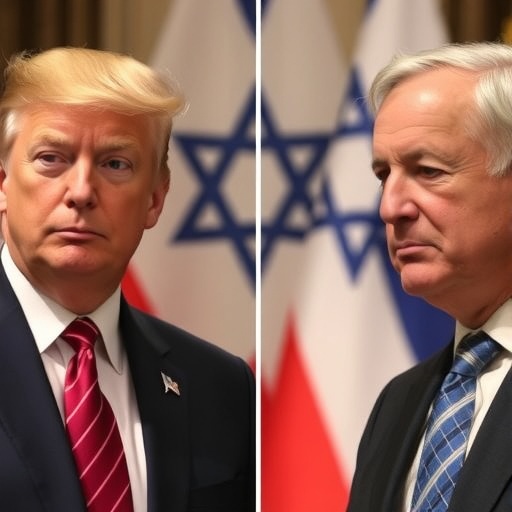Trump Administration Deploys Vance and Kushner to Israel as Netanyahu Threatens Gaza Ceasefire Collapse
In a high-stakes diplomatic maneuver, Vice President J.D. Vance has landed in Israel alongside envoy Steve Witkoff and former advisor Jared Kushner, aiming to salvage the fragile Gaza ceasefire teetering on the brink of collapse under Prime Minister Benjamin Netanyahu’s mounting pressures. U.S. officials, speaking anonymously, revealed deep-seated fears that Netanyahu’s government could unilaterally dismantle the U.S.-brokered agreement with Hamas, potentially reigniting one of the Middle East’s most volatile conflicts.
The delegation’s arrival in Jerusalem on Tuesday marks a rare show of force from the Trump administration, just months into its second term, underscoring the urgency of preserving a truce that has held for nearly six months. Sources close to the talks indicate that the ceasefire, which halted intense fighting in Gaza last fall, is now strained by Israeli military incursions and Hamas’s alleged violations, with both sides accusing the other of bad faith. “We’re not here to play games,” a senior U.S. official told reporters at Ben Gurion Airport. “The Gaza ceasefire is the linchpin for regional stability, and we’re prepared to do whatever it takes to keep it intact.”
This intervention comes amid escalating rhetoric from Netanyahu, who has publicly warned of resuming operations against Hamas if the group does not release more hostages or curb rocket fire from Gaza. The Israeli leader’s stance has alarmed Washington, where policymakers view the truce as a cornerstone of broader peace efforts, including normalization deals with Arab states. With over 1,200 Israeli deaths and more than 40,000 Palestinian casualties reported since the war’s onset in October 2023, the stakes could not be higher.
Vance Leads Charge in Jerusalem Talks with Netanyahu
Vice President J.D. Vance, stepping into a prominent foreign policy role early in the administration, spearheaded the initial meetings with Netanyahu and his cabinet upon arrival. Flanked by Witkoff, a real estate magnate turned Middle East envoy, and Kushner, whose 2017-2021 tenure saw him broker the Abraham Accords, Vance emphasized the U.S. commitment to Israel‘s security while urging restraint. “Israel’s right to defend itself is non-negotiable,” Vance stated in a press briefing outside the Prime Minister’s Office, “but dismantling the Gaza ceasefire would undo years of hard-won progress and invite chaos.”
The discussions, held in a secure room at the Kirya military headquarters, focused on immediate de-escalation measures. According to Israeli media outlets like Haaretz, Netanyahu expressed frustration over Hamas’s refusal to extend hostage negotiations, citing intelligence reports of the group’s rearmament efforts in Gaza. Vance countered by highlighting U.S. intelligence assessments showing that 70% of ceasefire violations stem from Israeli settler expansions in the West Bank, which indirectly fuel Hamas recruitment.
Diplomatic insiders describe the atmosphere as tense but productive, with Vance leveraging his Midwestern pragmatism to bridge divides. One anonymous Israeli official noted, “Vance isn’t just another suit from Washington; he’s got Trump’s ear and a no-nonsense approach that Netanyahu respects.” The trio’s presence also signals a revival of Kushner’s influence, whose past dealings with Gulf states could unlock financial incentives to bolster the truce.
Growing U.S. Concerns Over Netanyahu’s Hardline Shift
U.S. officials’ worries about Netanyahu’s intentions have intensified in recent weeks, fueled by a series of provocative statements and military actions. In a Knesset address last Friday, Netanyahu declared, “Hamas will never be allowed to rebuild its terror infrastructure,” hinting at potential airstrikes that could shatter the Gaza ceasefire. This rhetoric aligns with pressure from Israel’s far-right coalition partners, who demand a return to full-scale operations against Hamas strongholds in Gaza City and Khan Younis.
Washington’s apprehensions are not unfounded. A recent report from the U.S. Institute of Peace estimates that breaking the ceasefire could displace another 500,000 Palestinians, exacerbating the humanitarian crisis in Gaza, where aid organizations like the UN Relief and Works Agency (UNRWA) report acute shortages of food and medical supplies. “Netanyahu’s government is walking a dangerous tightrope,” said a State Department spokesperson. “The Gaza ceasefire was brokered with blood, sweat, and American guarantees—dismantling it risks alienating key allies.”
Behind the scenes, intelligence briefings to President Trump have painted a dire picture: Hamas, weakened but resilient, has smuggled in Iranian-supplied weapons via Sinai tunnels, while Israeli forces have conducted over 200 raids in Gaza since the truce began, ostensibly to enforce terms. These tit-for-tat actions have eroded trust, with Hamas leaders in Doha issuing ultimatums of their own. The Trump administration, drawing from its first-term playbook, is pushing for confidence-building steps, including a partial hostage release and eased blockades on Gaza imports.
Reviving the Fragile U.S.-Brokered Deal with Hamas
The Gaza ceasefire, painstakingly negotiated in November 2023 under intense U.S. mediation, represented a fragile victory amid the ashes of the October 7 Hamas attacks. That brutal assault, which killed 1,195 Israelis and took 251 hostages, prompted Israel’s sweeping retaliation, leveling much of Gaza and drawing international condemnation. The truce, which included phased hostage exchanges and humanitarian pauses, has since prevented a full resumption of hostilities, allowing limited aid flows and reconstruction in southern Gaza enclaves.
Yet, cracks have appeared. Hamas, designated a terrorist organization by the U.S. and EU, claims Israel has violated the agreement 150 times through drone surveillance and ground incursions. In response, the group has fired intermittent rockets, mostly intercepted by Israel’s Iron Dome system. U.S. envoy Steve Witkoff, known for his deal-making prowess from New York real estate circles, has been shuttling between Cairo, Doha, and Jerusalem to mediate. “This isn’t about picking sides,” Witkoff said in an interview with CNN. “It’s about enforcing the Gaza ceasefire that both Israel and Hamas signed onto.”
Jared Kushner’s return adds a layer of intrigue. During Trump’s first term, he cultivated ties with Saudi Arabia and the UAE, which could translate into economic leverage. Reports suggest the delegation is floating a $5 billion reconstruction fund for Gaza, conditional on Hamas demilitarization and Israeli withdrawal from buffer zones. Such incentives aim to make the ceasefire self-sustaining, addressing root causes like poverty and blockade-induced despair that fuel Hamas support.
Regional Ripples and International Reactions to the Crisis
The potential unraveling of the Gaza ceasefire has sent shockwaves across the Middle East, with neighbors like Egypt and Jordan voicing alarm over spillover effects. Egyptian President Abdel Fattah el-Sisi, who hosts key Hamas talks, warned that renewed fighting could destabilize the Sinai Peninsula and strain the 1979 peace treaty with Israel. In Jordan, where public sympathy for Palestinians runs high, protests have erupted outside the U.S. embassy in Amman, decrying American bias toward Netanyahu.
Internationally, the United Nations has called for urgent intervention. Secretary-General Antonio Guterres stated, “The Gaza ceasefire must not become another casualty of political expediency.” European leaders, including France’s Emmanuel Macron, have offered to host trilateral talks, while Iran’s foreign minister mocked the U.S. efforts as “futile meddling.” The involvement of J.D. Vance, a vocal critic of Iran during his Senate days, adds a confrontational edge, potentially deterring Tehran’s proxies from escalating.
Domestically in Israel, public opinion is divided. Polls from the Israel Democracy Institute show 55% of Israelis support maintaining the truce for hostage recovery, but 40% favor decisive action against Hamas. Netanyahu, facing corruption trials and coalition fractures, may see the crisis as a diversion. U.S. analysts warn that his domestic woes could push him toward brinkmanship, testing the Trump administration’s resolve.
Path Forward: Stakes for U.S.-Israel Ties and Middle East Peace
As the Vance-led delegation extends its stay through the weekend, expectations are high for breakthroughs that could extend the Gaza ceasefire by another 90 days. Proposed measures include joint monitoring teams along the Israel-Gaza border, funded by U.S. and EU contributions, and accelerated hostage talks mediated by Qatar. Failure, however, could prompt Trump to withhold military aid—a $3.8 billion annual package that’s Israel’s lifeline—or impose sanctions on settlement expansions.
Looking ahead, the outcome will shape U.S.-Israel relations under Trump 2.0. A preserved truce could pave the way for expanded Abraham Accords, incorporating Saudi Arabia and potentially isolating Hamas financially. Conversely, escalation might draw in Hezbollah from Lebanon or Yemen’s Houthis, broadening the conflict and straining U.S. resources amid global commitments. “This is a defining moment,” Vance remarked to delegates. “Preserving the Gaza ceasefire isn’t just about today—it’s about securing tomorrow for Israel, the Palestinians, and the entire region.”
With Netanyahu’s next cabinet meeting set for Thursday, all eyes are on whether diplomacy can prevail over division. The Trump administration’s bold deployment signals a proactive stance, but the road to lasting peace remains fraught with uncertainty.










